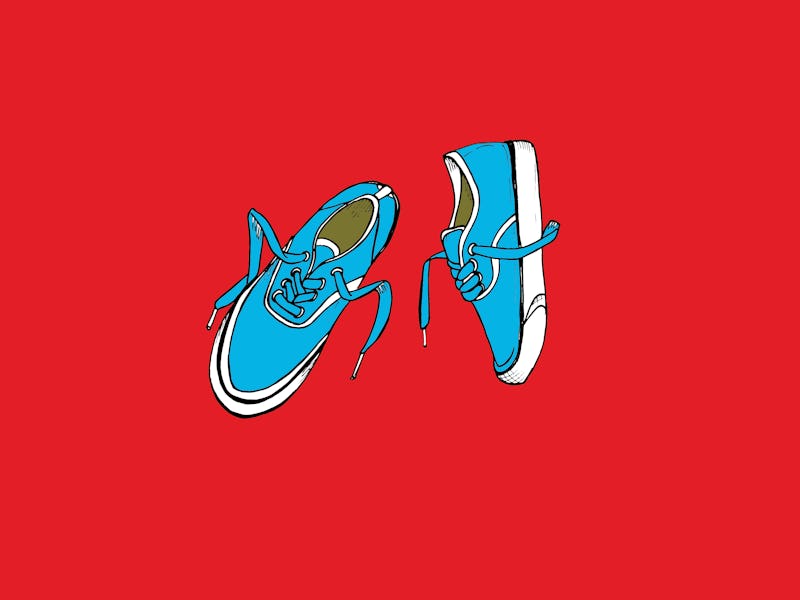This ancient innovation could change sneakers forever
Kirigami grips provide claw-like traction.

Grippy sneakers can mean the difference between a swift pivot shot and a sloppy turnover. Thanks to a team of material scientists from the U.S., Canada and Switzerland, nailing that shot could be easier than ever.
The team of researchers has designed new kirigami and animal-inspired shoe treads that intuitively provide more grip on slip prone surfaces like vinyl or ice. Compared to current tread technology, like clunky crampons worn around winter boots, this technology is more sleek and effective without sacrificing wearability.
These treads are still in the early stages of development, but future applications could change the way sports are played.
Kirigami patches can create 20 to 35 percent higher grip than sneakers or boots.
In a new study published Monday in the journal Nature Biomedical Engineering, the researchers describe how they decided to draw from both animals, like cheetahs, as well as the ancient Japanese art of paper cutting, kirigami, to build these grippy treads.
"Nature is a rich source of inspiration for friction-enhancement designs," write the authors. "These animals utilize anatomical structures and mechanisms to selectively and transiently increase friction on certain surfaces or in certain situations. For example, cheetahs have semi-retractable claws that increase friction when turning while chasing prey and climbing."
Kirigami is the ancient Japanese art of paper cutting to create elaborate, 3D sculptures without the use of glue. Material scientists have used this technique to build slithering robots and flexible machines.
Cheetahs were also a major inspiration.
Combining these animal instincts with the versatile properties of kirigami, a paper cutting art that can instantly transform from a 2D design into a 3D structure without glue, the team decided to build steel, claw-like kirigami strips that could be attached to the front of shoes. These strips are designed to flex into small, claw-like points when the wearer moves their foot to take a step and relax back down when the foot is flat, helping them keep their grip and balance during dynamic movement.
To test how well these treads worked on a real shoe, the team recruited three participants to test both the kirigami tread and control shoes without extra grippers ranging from snow boots to flat-top sneakers.
In these experiments, the team found that the kirigami grippers performed better than the non-grippy shoes. On icy surfaces, in particular, the kirigami grippers were ten times more effective than controls with flat steel bottoms and twice as effective as control shoes with textured steel bottoms.
Sahab Babaee, a researcher scientist from MIT and first author on the study, also tells Inverse that these kirigami patches create 20 to 35 percent higher friction (i.e., grip) than sneakers of boots alone.
Babaee says that these patches could be applied in any situation that stretches the kirigami material -- for example, charging toward the net for a layup.
"In general, the kirigami technology can be used for friction enhancement by engaging its needles/threads with the surface in contact, when stretched," says Babaee. "So, if you can provide a source of energy to induce stretch into the kirigami, you will be able to activate the needles to pop out and increase the friction."
These kirigami grippers are designed to lay flat when the wearer isn't walking and to open up into little claw-like spikes when they start to walk to provide extra traction and grip.
As the team continues to refine their design the researchers write that an important next step will be to include a textured surface at the back half of the shoe as well. The current design focuses on gripping the surface when the wearer begins to move their foot but this design does not include grip at the back to prevent slipping when putting the foot back down heel-first.
"[We envision] a top portion consisting of the kirigami pattern made of textured sheets to increase the friction in the push-off stage and a bottom portion (heel region) made of dimpled or tread groove patterns (no kirigami pattern) to generate higher braking forces and increase friction in the weight-acceptance phase and finally reduce the risk of slip."
The researchers also imagine that these future design would be flexible enough to fit any type of shoe -- from winter boots to basketball sneakers.
Abstract: Falls and subsequent complications are major contributors to morbidity and mortality, especially in older adults. Here, by taking inspiration from claws and scales found in nature, we show that buckling kirigami structures applied to footwear outsoles generate higher friction forces in the forefoot and transversally to the direction of movement. We identified optimal kirigami designs capable of modulating friction for a range of surfaces, including ice, by evaluating the performance of the dynamic kirigami outsoles through numerical simulations and in vitro friction testing, as well as via human-gait force-plate measurements. We anticipate that lightweight kirigami metasurfaces applied to footwear outsoles could help mitigate the risk of slips and falls in a range of environments.
This article was originally published on